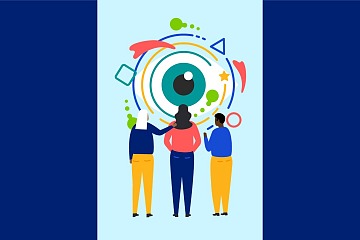DEIB, Diversity & Inclusion, Employee Experience, Innovation
Imagine this scene: You’re interviewing a potential candidate for a role as a developer with your company. The candidate seems to have the skills you need but also displays a few social eccentricities – perhaps he has a tick, or rocks back and forth in his seat, or won’t make eye contact.
For decades, potential hires like this have been rejected from the candidate pool. “Poor culture fit” has typically been the rationale.
But what if in the hunt for the “right culture fit,” you’re rejecting an entire pool of highly qualified – maybe even the best qualified — workers?
What is neurodiversity?
Neurodiverse individuals are those with developmental disabilities such as autism, ADHD, and social anxiety disorders.
While some neurodiverse people may struggle with social skills, they tend to have above-average abilities when it comes to things like analysis, information processing, and pattern recognition.
An untapped pool of potential
For those living on the autism spectrum, finding a job suited to their skillset can be an immense challenge. In fact, Drexel University’s National Autism Indicators Report says 51% of workers on the spectrum have skills higher than what their job requires. Meanwhile, fewer than one in six adults with autism even have full-time employment.
Michael Ando, is on the autism spectrum and an employee at EY. He told the audience at the Great Place To Work® company culture conference about autistic friends with advanced degrees who could only get jobs dishwashing, cashiering, or working in warehouses.
“All of these jobs are fine, but if you have spent years getting degrees … it’s a shame and a waste they weren’t able to use them,” he said.
But some companies are actively seeking to create more neurodiverse workforces. Michael, for example, was hired under EY’s neurodiversity program.
Even governments are turning to neurodiversity. America’s National Geospatial-Intelligence Agency (NGA), for example, is piloting a program that aims to change how neurodivergent job candidates are recruited, hired, and retained for federal positions. The NGA needs the skills that individuals on the autism spectrum bring – such as attention to detail, problem-solving, and out-of-the-box thinking.
In Israel, the Israeli Defense Forces (IDF) has a team staffed primarily with people on the spectrum, as they tend to see patterns in data that others cannot. And in Australia, the Defense Department is borrowing assessment methods from the IDF to develop a neurodiversity program in cybersecurity.
Advantages of neurodiversity in the workplace
Increasing neurodiversity in the workplace is especially advantageous now. That’s because neurodiverse people possess vital skills that businesses will need as they adopt more advanced technology.
For example, as businesses increase their use of artificial intelligence and robotics, the demand for STEM (science, technology, engineering, and math) talent also increases, and neurodiverse workers often excel in these areas.
Hiren Shukla, Neuro-Diverse Centre of Excellence leader at EY, explained how processes that took two to three hours were reduced to just two minutes, thanks to programming by members of their neurodiverse workforce. These employees were able to see inefficiencies that neurotypical employees had either become used to or had never even noticed.
“Their thought process and their delivery are different from what we are used to,” Hiren said.
But a strong neurodiversity program isn’t just beneficial to employees on the spectrum. In EY’s case, not only have they been able to find great talent, but they’ve also created better managers who look at individual needs.
It’s also helped with company-wide communication. Managers now avoid abstract language, use shorter words, and give more specific instructions — clarity that has benefited everyone.
More research has found that when companies introduce improved communications programs or inclusive collaboration tools, every employee benefits.
7 keys to greater workplace neurodiversity
Building a more neurodiverse workforce requires more than simply not rejecting candidates who display signs of neurodiversity. You’ll need to look at your hiring, onboarding, and other people management practices to see how they may affect neurodiverse employees.
Here are seven keys to a successful neurodiversity program:
1. Get buy-in from all levels
Engage with leadership so that they, in turn, can have conversations with their teams about what it means to have a neurodiverse workforce.
It’s important that these conversations are open and transparent. It needs to be a safe space for both neurotypical employees to ask questions and for neurodiverse employees to come forward and disclose.
2. Engage with the local community
Community groups can help employers find and attract neurodiverse talent. These groups may take the form of government agencies, non-profits, vocational rehab centers, educational institutions, or offices for disabilities.
In addition to helping with recruitment, such groups can provide crucial advice and resources for training.
Hiren said connecting with the community was a win-win. These agencies were trying to find meaningful work for individuals on the spectrum, and EY needed help finding those individuals.
3. Adjust your hiring practices
Hiring managers need to reframe their idea of what makes a “good candidate.” Many superficial norms, such as a strong handshake or looking someone in the eye, are difficult for neurodiverse individuals to perform.
Managers also need to ask the right questions to best draw out the individual’s skills and capabilities. For example, EY took the surprise element out of their interview process — if the candidate is not applying for a job that requires them to think fast on their feet, then there’s no need to consider that in the interview.
Also, it’s important to remember that resumes don’t tell the full story. Because so many neurodiverse individuals have struggled to find work that matches their abilities, they are often self-taught or possess transferrable skills.
4. Be patient
Building a neurodiverse candidate pool takes time. EY uses a two-week process that is focused on hiring people as team members rather than as individuals.
Week one is virtual, relying on video calls, virtual exercises and assessments through mini-projects. Week two is called “Superweek” and is held on-site. This week includes team-based work simulations and interpersonal skills development.
At the end of the two weeks, EY selects the highest performers and hires in cohorts. From there, all onboarding and training is done by managers who have taken formal training in autism.
5. Organize expert-driven, two-way training
Soft skill training is a critical part of building a neurodiverse workforce and should be done by an expert with the appropriate experience – something you can also look to the local community for.
Note that this training isn’t just for neurodiverse employees, but for all employees and especially managers, who need to be educated about what it’s like to be on the spectrum, and how to best work together.
“Interpersonal difficulties are no barriers to a high-performing team,” said Michael.
6. Be ready and willing to accommodate
Individuals with autism may be sensitive to things like temperature, sound, and lighting. As such, you may need to provide accommodations such as noise-canceling headphones, privacy rooms, or flexible work schedules, so employees can be their most productive.
“If an individual has an issue staying still for more than 45 minutes at a time… [they should] go for a walk and come back. As long as you’re productive when you come back, we’re okay with it,” said Hiren.
7. Amplify the message
Individuals on the spectrum have often had negative experiences in the world. So, while they may feel understood at work, they may not feel as safe outside of the office.
A strong neurodiversity program should push its message externally as well as internally, making it a more normal part of employment in general.
EY is open-sourcing its work, along with other companies pursuing neurodiversity, through the Autism at Work Roundtable.
“This is giving us a tremendous amount of reputational value,” said Hiren. “It’s good for our own employees, it’s good for the marketplace. Our clients want to do business with companies that do good. Candidates want to work with companies that do good.”
Building – and supporting – a diverse workforce starts with data
Having a systematic and continuous way of gathering feedback around the employee experience provides the data and insights needed to create a roadmap for affecting positive change. Gather and analyze your employees’ experience with our tool that combines an employee survey and Great Place To Work Certification™ in one place.














